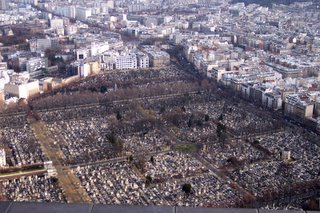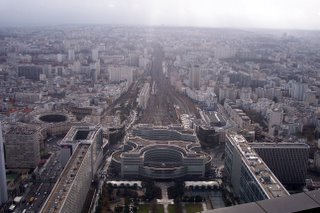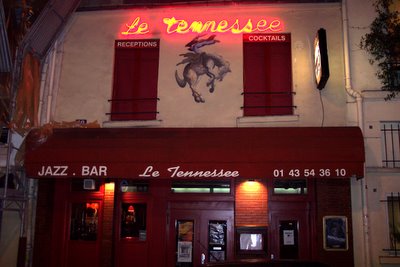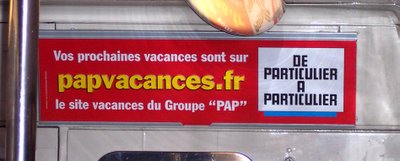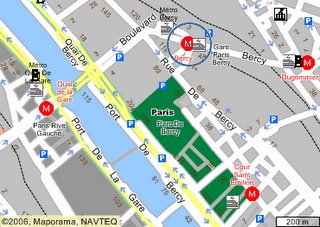Today, there was a new comment posted to the earlier discussion about
Francophobia in the US. (I know who posted it, but since that person signed anonymously, I'll refrain from revealing the identity.) Here's an excerpt:
"My last reason for my dislike of the French is my own experiences. I have been to Paris twice-- once in 1963 and again in 1994. Each time my contacts with the people were for the most part not pleasant. I encountered that anti-American attitude. I have also met many Americans who have had the same problems. In 1960 a good friend of mine visited Paris. The dislike of Americans was so strong that the American Embassy suggested American tourists eat there for their own safety."
I can't speak to the experiences that Americans had in the 1960's, though I trust this source's description. I know that the 60's were a particularly unstable decade in French history, so I can understand why Paris wouldn't have been the most pleasant place to visit. This person's experiences in the early 1990's, I suspect, has a lot to do with the fact that he/she was traveling with an extremely large tour group that consisted of mostly teenagers. I don't know about you, but when I run into a tour group *anywhere* in the world, I'm not exactly thrilled. It doesn't matter if the whole group is polite -- there are too many people in one place, and they are in my way!
What I can address, however, is why so many Americans seem to have a lousy time when they visit Paris today. It's a direct result of A) poor planning, and/or B) little to no attempt to understand and work within the cultural norms of a different society. (It may also involve their participation in a large tour group, but I'm speaking specifically to individuals who come overseas to travel.)
Poor planning is pretty straightforward: if you don't have maps, reservations, enough time, enough money, etc ... you're not going to have a good time because your trip won't go smoothly. You'll miss trains, skip meals, and wait for hours in long lines for things that don't impress you when you're hungry and irritated. My advice for this is simple: do your homework! Don't just book plane tickets and assume that
spontaneity is going to be the most fun. You don't have to plan out a minute-by-minute itinerary, but it helps to know when things are open, how to avoid long lines, and so forth. If you're planning a trip to Europe, I HIGHLY recommend purchasing the Rick Steves' guidebooks, as well as visiting his website at
ricksteves.com. This guy knows Europe better than the back of his hand! So, to quote him:
"Guidebooks are $25 tools for $3,000 experiences. ... Too many people are penny-wise and pound-foolish when it comes to information. I see them every year, stranded on street corners in Paris — hemorrhaging money. It's flipping off of them in €100 notes. Con artists smell a helpless victim and close in. These vacations are disasters. Tourists with no information run out of money, fly home early, and hate the French. With a good guidebook, you can come into Paris for your first time, go anywhere in town for the equivalent of a dollar on the subway, enjoy a memorable bistro lunch for $10, and pay just $60 for a double room in a friendly hotel on a pedestrian-only street a few blocks from the Eiffel Tower — so French, that when you step outside in the morning you feel you must have been a poodle in a previous life. All you need is a good guidebook covering your destination."
Having said all of that, please feel free to e-mail me with questions if you're coming to Paris soon. I'm happy to dispense advice, for whatever it's worth! :)
Little to no understanding of cultural norms is the other major cause of American dislike of the French when traveling abroad. I'm not saying that every last French person loves America - in fact, there are quite a few people who hate it. (To be fair, there are a lot of *Americans* who hate America, too!) However, there are a lot of little unspoken rules that tourists regularly violate in Paris. When they get a negative reaction as a result, they assume that it's because the French are rude. OK, sometimes they are. But sometimes, they have a good reason to be - we were rude first!
"Outsiders go wrong by looking at France through their own optics. It is always a jolt for veteran travelers to find that culture shock in France is more severe than in Saudi Arabia or Bolivia. Elsewhere, things look and sound different, so you expect them to be different. France looks like home, or at least like familiar old postcards and paintings. Surprise..." (Mort Rosenblum in
Mission to Civilize, as quoted on the back cover of
Culture Shock: France by Sally Adamson Taylor)
This quote really struck a chord with me because I genuinely think that this is the reaction of countless American tourists when they come to Western Europe. After all, these are our ancestors, right? How many of us "Americans" can trace our lineage back to the British, the French, the Germans, the Irish, the Greeks, etc? And even for those Americans who trace their lineage to other continents, no doubt they expect to get a lot of the same attitudes and customs that they have come to know in the US because of this common heritage. We
expect France to be similar to the US. The only real difference is the language barrier, right? And English is really the universal language anyway, so we should be fine, right?
WRONG! There are different customs, traditions, etiquettes, attitudes, and so forth here in France, and if you don't know about them, you just might stick your foot in your mouth without ever realizing it. That's why, when I have guests visiting, I give them a few ground rules to get them going in the right direction:
RULE #1: Greet the "help"When entering a store, look for the nearest salesperson and greet them with "Bonjour, Monsieur/Madame." (Simply saying "Bonjour!" can come across a bit terse, so don't be afraid to add on the Monsieur/Madame.) When you leave the store, be sure to say, "Merci, Monsieur/Madame. Au revoir." If you really want to, you can also add on "Bonne journée" (have a good day), but saying goodbye is sufficient.
Why? In general, there is more of a personal sense of ownership of businesses. Walking into a someone's store is perceived similarly to walking into someone's house: you wouldn't just walk into someone's house without so much as a glance in their direction, would you? So, not saying hello or goodbye is often perceived as being rude. Granted, this is less of an issue in big department stores, but it's still nice to acknowledge the salesperson's presence when walking in.
RULE #2: Learn a little lingoLearn a little bit of French before you come. I know, you won't be fluent. Don't worry about it - neither am I. Make an earnest attempt to speak the home team's language, even if you're reading straight out of a phrase book that you bought at Barnes and Noble. I recommend practicing outloud with another person, so that you can get used to the sound of your voice before you have to put it out there for the "natives" to hear.
Why? Let me explain by offering an example in the US. How many times have you heard Americans complain about "all those immigrants" who come into the country and "don't bother" to learn English? After all, if you're going to live in America, you have to speak our language. We're not going to cater to you. So, why expect the French to react any differently? It's frustrating for everyone involved when you can't communicate the simplest of ideas. Make an effort, and 99 French people out of 100 will appreciate it and try their best to help you. Also, if you make the basic effort, many Parisians will recognize your accent and start speaking English to you. If you tick them off by insisting on English from the first moment you speak, they are far more tempted to pretend that they have no idea what you're saying. (Colin knows someone who has witnessed this first hand.)
Also, if you know some basic French vocabulary, you'll be able to read signs and figure out where to go on your own. Result? Less time wandering around lost, nevermind working up the courage to ask a stranger where something is.
RULE #3: Don't be put off if you aren't immediately embracedFrench people don't even embrace each other right away. Unlike Americans, who will invite complete strangers into their homes for a party, the French much prefer to have a few intimate friends instead of tons of acquantances. You can see this in our demeanors, too: Americans tend to smile and be more assertive, whereas the French see an inexplicably smily person as either stupid or up to no good. The French "coolness" has nothing to do with their deep-seated disgust for the US - they just don't throw themselves out there quite like we do. (On the bright side, if you make a French friend, they will be the
best friend you can imagine!)
There are so many more things I could relate, but instead, I'll recommend a book to check out. It's called
Culture Shock: France, written by Sally Adamson Taylor. The
Culture Shock books are a series - there are different versions for many different cultures (including New York and Chicago). I haven't read any of the others, but I've heard that the one for Australia is also quite useful. At any rate, you'll get a lot of practical, useful information out of this book that will help you understand why the French react the way that they do to specific things. Knowing some of the major differences between your culture and the one you are going to visit can go a long, long way to turning a decent trip into the trip of a lifetime.
In closing, I offer this last bit of advice: remember that there are jerks in every neighborhood of every city in every country. If you run into one of them, don't let it ruin your day. Find someone in a better mood, try again, and remember that one or two people can't possibly represent an entire nation any better than you can represent all that is good or bad about the US.
Postscript: After Colin read this blog entry, he said he felt like he was reading plagiarized work. So, as a disclaimer: I tried really hard to cite every idea to its appropriate source! If you recognize anything that should be attributed but isn't, please let me know. The vast majority of this isn't my own unique thoughts, but a synthesis of what has stood out to me from all of the French culture/travel books I've read.




